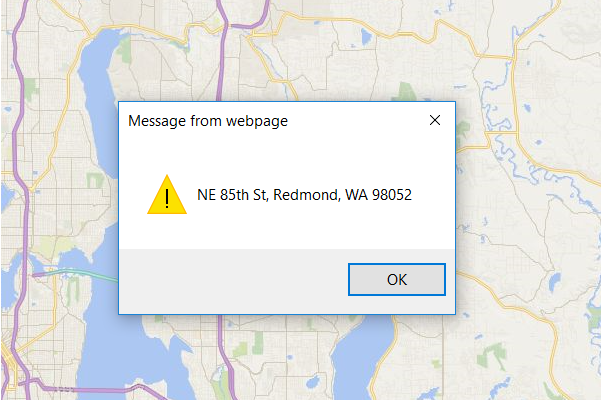Basic Reverse Geocode Example
Note
Bing Maps Web Control SDK retirement
Bing Maps Web Control SDK is deprecated and will be retired. Free (Basic) account customers can continue to use Bing Maps Web Control SDK until June 30th, 2025. Enterprise account customers can continue to use Bing Maps Web Control SDK until June 30th, 2028. To avoid service disruptions, all implementations using Bing Maps Web Control SDK will need to be updated to use Azure Maps Web SDK by the retirement date that applies to your Bing Maps for Enterprise account type. For detailed migration guidance, see Migrate from Bing Maps Web Control SDK and Migrate Bing Maps Enterprise applications to Azure Maps with GitHub Copilot.
Azure Maps is Microsoft's next-generation maps and geospatial services for developers. Azure Maps has many of the same features as Bing Maps for Enterprise, and more. To get started with Azure Maps, create a free Azure subscription and an Azure Maps account. For more information about azure Maps, see Azure Maps Documentation. For migration guidance, see Bing Maps Migration Overview.
The following code sample shows how to make a reverse geocode request using the Search module. This code loads the search module if it isn’t already loaded. It then reverse geocodes the center of the map and, if successful, it will show a message on the screen with the display name (often an address) of the reverse geocoded location.
<!DOCTYPE html>
<html>
<head>
<title></title>
<meta charset="utf-8" />
<script type='text/javascript'>
var map, searchManager;
function GetMap() {
map = new Microsoft.Maps.Map('#myMap', {
credentials: 'Your Bing Maps Key',
center: new Microsoft.Maps.Location(47.678, -122.133),
zoom: 11
});
//Make a request to reverse geocode the center of the map.
reverseGeocode();
}
function reverseGeocode() {
//If search manager is not defined, load the search module.
if (!searchManager) {
//Create an instance of the search manager and call the reverseGeocode function again.
Microsoft.Maps.loadModule('Microsoft.Maps.Search', function () {
searchManager = new Microsoft.Maps.Search.SearchManager(map);
reverseGeocode();
});
} else {
var searchRequest = {
location: map.getCenter(),
callback: function (r) {
//Tell the user the name of the result.
alert(r.name);
},
errorCallback: function (e) {
//If there is an error, alert the user about it.
alert("Unable to reverse geocode location.");
}
};
//Make the reverse geocode request.
searchManager.reverseGeocode(searchRequest);
}
}
</script>
<script type='text/javascript' src='http://www.bing.com/api/maps/mapcontrol?callback=GetMap' async defer></script>
</head>
<body>
<div id="myMap" style="position:relative;width:600px;height:400px;"></div>
</body>
</html>
Here is what the result looks like when centered over a location in Redmond, WA.
